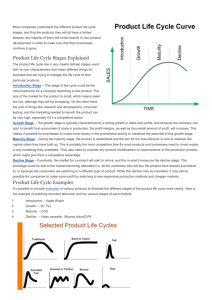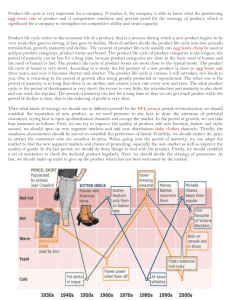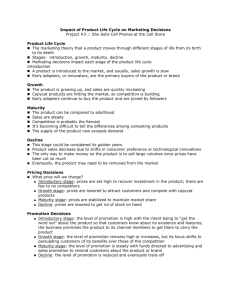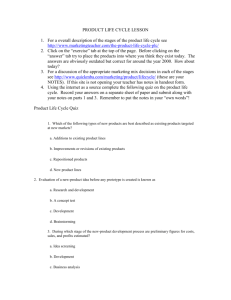growth
advertisement
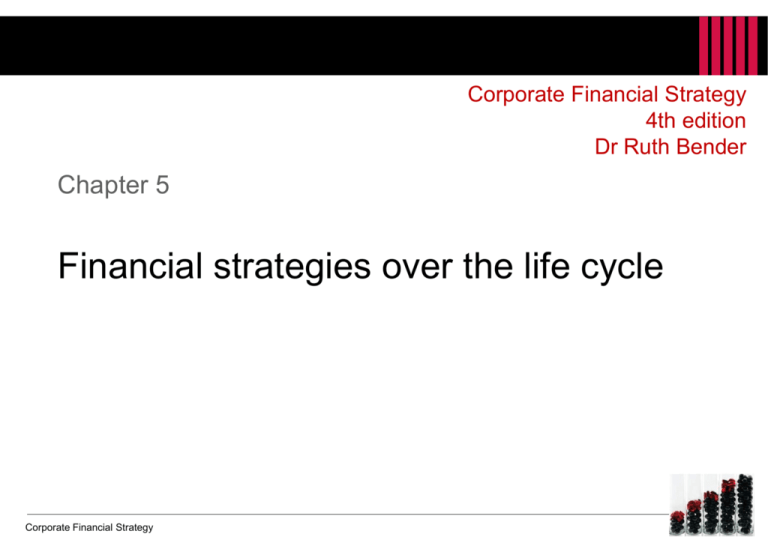
Corporate Financial Strategy 4th edition Dr Ruth Bender Chapter 5 Financial strategies over the life cycle Corporate Financial Strategy Financial strategies over the life cycle: contents Learning objectives Life cycle model Shake-out period Portfolio matrix incorporating product life cycle [with names] Portfolio matrix incorporating product life cycle [with pictures] Unknowns decrease over the life cycle Net cash flows at different stages of development Modified Ansoff matrix Financial strategy changes over the life cycle Cost of capital in a divisional structure Corporate Financial Strategy 2 Learning objectives 1. Understand what financial strategy is, and how it can add value. 2. Explain why shareholder value is created by investments with a positive net present value. 3. Appreciate how the relationship between perceived risk and required return governs companies and investors. 4. Differentiate the different models of measuring shareholder value. 5. Explain why share price is not necessarily a good proxy for company value. 6. Outline how agency theory is relevant to corporate finance. Corporate Financial Strategy 3 Life cycle model Launch Maturity Growth Decline £ Sales 0 Time Profits Cash flows Corporate Financial Strategy 4 Shake-out period Anticipated sales forecast used to justify capacity increases Sales / capacity Overcapacity position Actual sales level Historical fast growth in sales Time Corporate Financial Strategy 5 Portfolio matrix incorporating product life cycle High Star ? Rate of market growth Cash cow Dog Low/negative High Low Relative market share Based on Boston Consulting Group Corporate Financial Strategy 6 Portfolio matrix incorporating product life cycle High Rate of market growth Low/negative High Low Relative market share Based on Boston Consulting Group Corporate Financial Strategy 7 Unknowns decrease over the life cycle LAUNCH Product risk Market acceptance Market share Size of market at maturity Length of maturity period Maintenance of market share Rate of eventual decline Corporate Financial Strategy GROWTH MATURITY Market share Size of market at maturity Length of maturity period Maintenance of market share Rate of eventual decline 8 Length of maturity period Maintenance of market share Rate of eventual decline DECLINE Rate of eventual decline Net cash flows at different stages of development GROWTH LAUNCH Cash inflow Sales High Cash outflow Marketing, fixed assets, Working capital, etc. High Cash inflow Sales Low Cash outflow R&D, launch Marketing, fixed assets, etc. High Net cash flow ? Net cash flow Negative Cash flow starts negative, becoming neutral or positive MATURE DECLINE Cash inflow Sales Cash outflow Ongoing cost base Cash inflow Sales Cash outflow Maintenance Net cash flow High Low Positive Net cash flow Low Low Negative Cash flow starts positive, becoming neutral Corporate Financial Strategy 9 Modified Ansoff matrix Products Existing Existing Core business growth strategy Related New Customerled growth strategy Markets Related Productled growth strategy Diversification strategy New Corporate Financial Strategy 10 Financial strategy changes over the life cycle Corporate Financial Strategy GROWTH LAUNCH Business risk high Financial risk low Funding equity (float) Dividend payout nominal Growth high P/E high Eps low Share price growing & volatile Business risk very high Financial risk very low Funding equity (venture capital) Dividend payout nil Growth very high P/E very high Eps nominal Share price growing & highly volatile MATURITY DECLINE Business risk medium Financial risk medium Funding debt Dividend payout high Growth medium / low P/E medium Eps high Share price stable with limited volatility Business risk low Financial risk high Funding debt Dividend payout total Growth negative P/E low Eps declining Share price declining & volatile 11 Cost of capital in a divisional structure This extract from the financial report of Henkel shows that divisions with different risk profiles are given different WACCs Source: Henkel 2012 financial statements, page 54 www.henkel.com Corporate Financial Strategy 12


